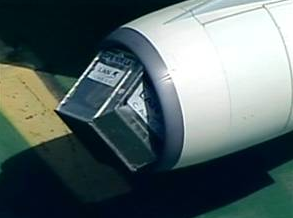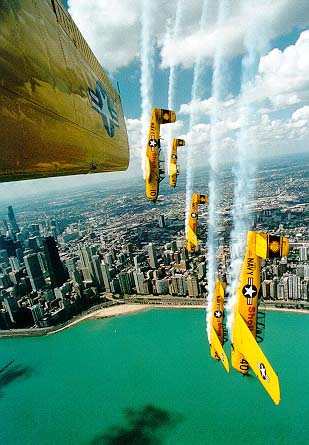““Instrument flying is when your mind gets a grip on the fact that there is vision beyond sight” - U.S. Navy Approach magazine circa W.W.II.
Flying in instrument conditions takes practice. It’s not like riding a bike. Yesterday I headed to the home drome to gain more proficiency since flying Visual Flight Rules (VFR) into instrument meteorological conditions (IMC) is the #1
cause of all weather related accidents and 91% of them
are fatal. According to a University of Illinois study, the average life expectancy of a non-instrument rated pilot who flies into instrument meteorological conditions is short, with only
178 seconds to live. Less than three minutes and it’s over if you don’t respect cloud conditions and poor visibility. So up I went and flew “precision” (with vertical guidance) and non precision approaches (that’s a type of approach
not the way I flew). These were all flown within standards, but holding patterns in high winds needed more work. There's a distinct difference between being legal and being proficient to fly.
Given the short life expectancy of untrained pilots who venture into IMC, as new pilots we were all taught to avoid clouds at all costs, as if they were deadly phantoms waiting to devour the unsuspecting aviator. An instrument rating allows you to fly into the maw of the deadly ether and find ,that with training, it’s only water. It’s work if you hand fly a plane without an autopilot for an extended period: Intense concentration and a high workload flying as single pilot. One of the compensations for your trouble can be the transformation of a gray, dreary day into something more spectacular when you break through the clouds. You can be rewarded with this.

but usually it looks like this:

Years ago I learned the importance of practice. I launched into the overcast with another instrument rated pilot. About 30 minutes into the flight , I mentioned that I was getting “the leans” to which the other pilot responded “ yeah-I’ve got vertigo too. Spatial disorientation can sneak up on you so you pay strict attention to the instruments. There was no autopilot. I reset the directional gyro and attitude indicator since they seemed slightly incorrect which should have been a clue. Ten minutes later, air traffic control advised we were to steer a new heading to stay on course. I looked up at the wet compass and the heading was not only off but the turn coordinator showed a left turn. The vacuum pump was dying and the instruments, to which I always referred, were useless. I slapped some paper over each one so as to exclude them in the panel scan. I was dizzy, trying to maintain a heading with a bouncing compass and following radar vectors into a climb. I thought of
John F Kennedy jr. and his death caused presumably by a graveyard spiral. VFR into IMC also led to the
“Day the Music Died” , the tragedy that included Buddy Holly, Richie Valens and JP Richardson.
The other pilot, who was a CFII took over and he was having trouble as well staying on heading. The scan was disrupted and he was working from the left seat. For three minutes the outcome of this event was very much in doubt. We contacted ATC and planned to declare an emergency, requesting a no gyro approach. We went to the head of the line, becoming the number one customer of the air traffic controller who was directing us to the nearest airport in Wisconsin. Supposedly, the ceiling was 800 feet. There was a precision approach available but it was probable we would break out of the soup and wouldn’t need to ride it down to decision altitude. (Altitude at which you reject the approach if you cannot see runway identifiers,). I wondered if it was even possible to make a missed approach with partial panel if it came to that. We continued a steady decent rate until the medium gray became lighter gray.
We broke out of the clouds. Although this airport had a MALSF, with “the rabbit” (sequenced flashing lights leading to the runway) none was needed. The landing was assured. Gyroscopic instruments run off vacuum pumps which can fail over time. This supposedly
led to the death of Missouri Governor Mel Carnahan in 2000. Training makes a difference as demonstrated by this naval aviator of an E-2 Hawkeye who
had instrument problems and made a successful landing. Lessons learned. a) Instrument flying requires proficiency. b) Check the maintenance logs on the aircraft. c) Fly a plane with two pumps if venturing into hard IMC and if you have the green: fly a
new plane with a glass cockpit. You need to pay attention. Don't end up in this situation:





 The piper pilot couldn’t understand why the plane no longer responded to his control inputs. The Cessna flight instructor, below, realized that the Piper had landed on top of him and that he was now flying for two. Luck and skill prevented a disaster. Pilots walked away unharmed and both planes were repaired and flew again.
The piper pilot couldn’t understand why the plane no longer responded to his control inputs. The Cessna flight instructor, below, realized that the Piper had landed on top of him and that he was now flying for two. Luck and skill prevented a disaster. Pilots walked away unharmed and both planes were repaired and flew again.




 Sometimes I'm lucky and I'll see one or more of the yellow T-34’s flying overhead on approach to runway 2L at KDPA. Then, I want to go flying.
Sometimes I'm lucky and I'll see one or more of the yellow T-34’s flying overhead on approach to runway 2L at KDPA. Then, I want to go flying.



